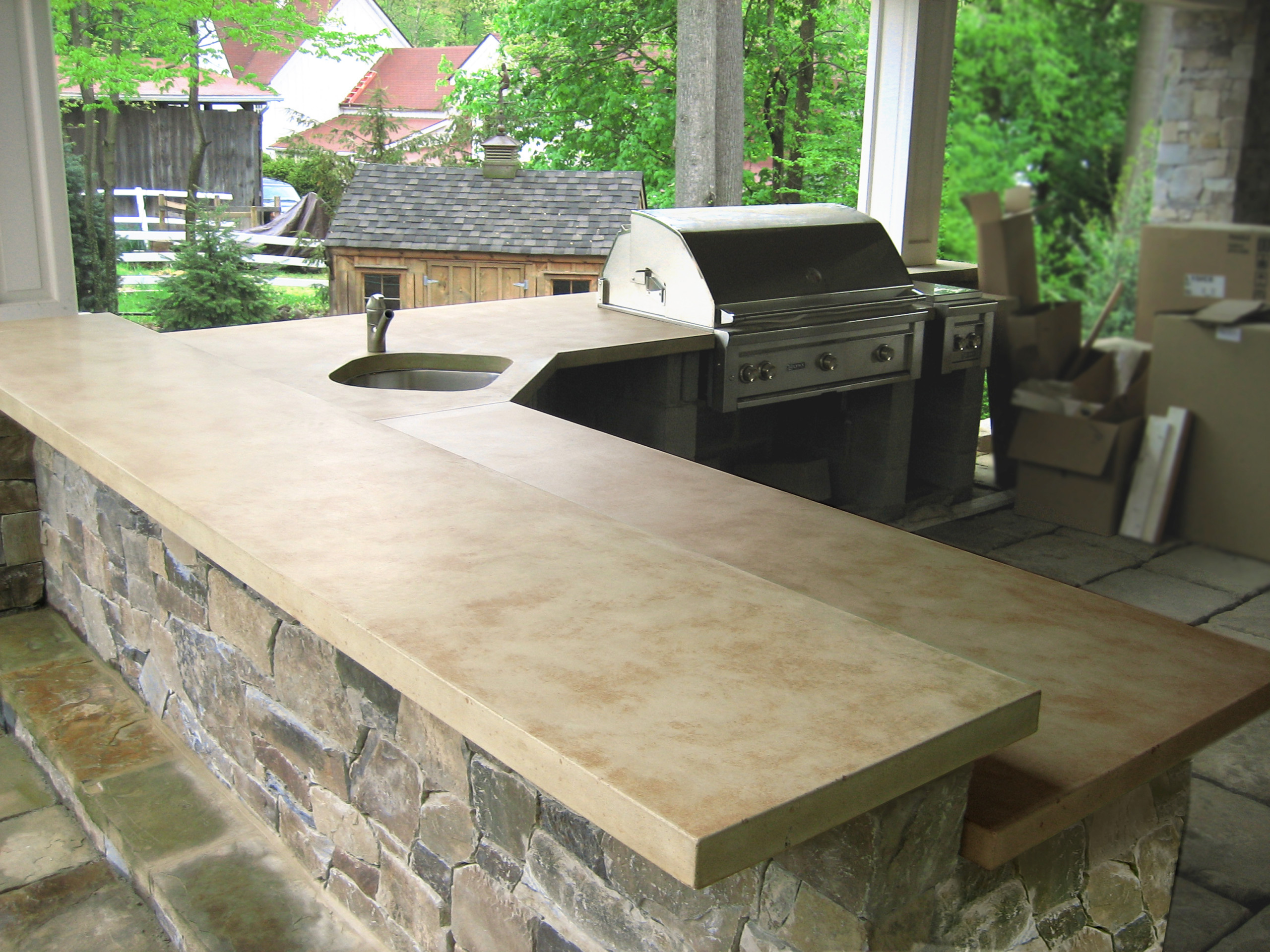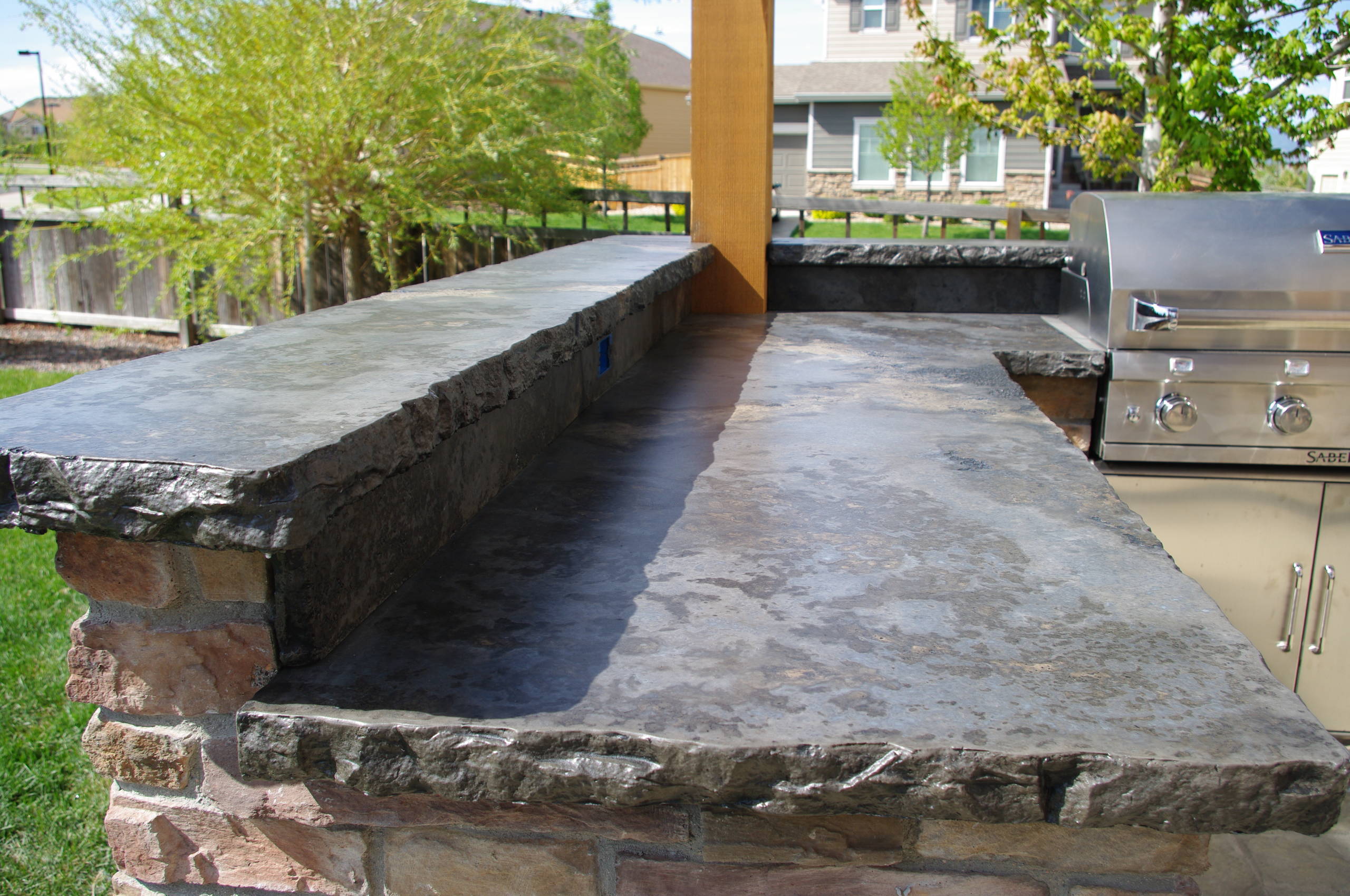Embark on a journey into the world of concrete outdoor countertops, where functionality meets aesthetics. Discover the versatility, durability, and limitless design possibilities that make concrete the perfect choice for transforming your outdoor living areas.
Concrete outdoor countertops offer a unique blend of strength, durability, and aesthetic appeal, making them an ideal choice for a wide range of outdoor applications. Whether you’re looking to create a stylish outdoor kitchen, a cozy fire pit surround, or a durable patio table, concrete countertops provide endless opportunities to enhance your outdoor spaces.
Material Characteristics and Applications

Concrete, a composite material composed of cement, aggregates (such as sand and gravel), and water, offers a robust and versatile option for outdoor countertops. Its inherent strength and durability make it well-suited for withstanding the elements and heavy use.
Types of Concrete Mixes for Outdoor Use
Various concrete mixes are formulated to optimize performance for outdoor applications. These include:
- Portland Cement Concrete:Commonly used for its strength, durability, and resistance to freeze-thaw cycles.
- Fiber-Reinforced Concrete:Incorporates fibers (e.g., glass, polypropylene) to enhance toughness and reduce cracking.
- Air-Entrained Concrete:Introduces air bubbles to improve freeze-thaw resistance and durability.
- Polymer-Modified Concrete:Adds polymers to enhance strength, flexibility, and resistance to chemicals and stains.
Advantages of Concrete Outdoor Countertops
- Durability:Concrete’s strength and resistance to wear and tear make it a long-lasting choice for outdoor use.
- Weather Resistance:Its ability to withstand extreme temperatures, moisture, and UV rays ensures longevity in outdoor environments.
- Customizable:Concrete can be molded into various shapes and textures, allowing for personalized designs.
- Low Maintenance:Once sealed, concrete countertops require minimal maintenance compared to other materials.
Disadvantages of Concrete Outdoor Countertops
- Weight:Concrete is a heavy material, which can make transportation and installation challenging.
- Susceptibility to Staining:Unsealed concrete can absorb stains from liquids and food, requiring regular sealing.
- Cracking:Concrete is prone to cracking under stress, although proper reinforcement and installation can minimize this risk.
- Heat Retention:Concrete retains heat, which can be uncomfortable to touch in hot climates.
Design Considerations and Aesthetics
Concrete outdoor countertops offer a vast array of design possibilities, allowing you to create a unique and visually stunning outdoor space. When designing your concrete countertop, consider the following factors:
Shape and Size
The shape and size of your countertop will depend on the size and layout of your outdoor space. For smaller spaces, a compact rectangular or square countertop may be suitable. Larger spaces can accommodate more elaborate shapes, such as L-shaped or curved countertops.
Consider the traffic flow and intended use of the countertop when determining its size and shape.
Finish
The finish of your concrete countertop will impact its overall appearance and durability. Smooth finishes create a modern and sleek look, while textured finishes add a touch of rustic charm. You can also choose from a variety of colors and stains to match your outdoor décor.
Customization
Concrete countertops offer endless possibilities for customization. You can embed materials such as glass, stone, or metal to create unique designs. You can also add pigments or stains to achieve a specific color or pattern. The versatility of concrete allows you to create a countertop that perfectly complements your outdoor space.
Construction and Installation Techniques

Constructing and installing concrete outdoor countertops involves meticulous steps to ensure durability and aesthetics. Understanding the process and adhering to proper techniques is crucial for a successful outcome.
Forming
The initial step is creating the formwork that will define the shape and dimensions of the countertop. Use high-quality form boards or plywood, ensuring they are sturdy enough to withstand the weight of the concrete. Secure the formwork firmly to prevent any movement or deformation during the pouring process.
Pouring
Prepare the concrete mix according to the manufacturer’s instructions. The ideal concrete mix for outdoor countertops should have a compressive strength of at least 3,000 psi. Pour the concrete into the formwork, ensuring it fills all corners and voids. Vibrate the concrete using a concrete vibrator to remove any air pockets and create a dense, uniform surface.
Curing
Allow the concrete to cure properly by maintaining moisture and temperature. Cover the countertop with plastic sheeting or wet burlap to prevent rapid evaporation. The curing time typically ranges from 7 to 28 days, depending on the ambient temperature and humidity.
Installation
Before installing the countertop, prepare the base by leveling it and ensuring it can support the weight of the concrete. Apply a layer of adhesive to the base and carefully place the countertop in position. Use shims or spacers to adjust the height and level as needed.
Sealing
To protect the countertop from moisture penetration and staining, apply a high-quality concrete sealer. Choose a sealer specifically designed for outdoor use and follow the manufacturer’s instructions for proper application. Sealing should be repeated periodically to maintain the countertop’s durability and appearance.
Seamless Transitions, Concrete outdoor countertops
Creating seamless transitions between the countertop and other outdoor elements enhances the overall aesthetic and functionality. One method is to use expansion joints, which allow for movement between different materials. Another option is to use integral color or stains to match the countertop to the surrounding surfaces.
Maintenance and Care

Concrete outdoor countertops require regular cleaning and maintenance to preserve their appearance and longevity. Proper care can prevent staining, damage, and premature deterioration.
Regular Cleaning:Clean the countertop regularly with a mild soap solution and a soft cloth or sponge. Avoid using abrasive cleaners or scrubbers, as these can scratch the surface.
Sealing
Sealing the countertop is essential to protect it from stains and moisture penetration. Apply a penetrating sealer designed for outdoor concrete surfaces. Follow the manufacturer’s instructions carefully, applying multiple coats as needed.
Staining and Damage Prevention
To prevent staining, wipe up spills immediately. Use coasters under glasses and hot pots to avoid heat damage. Avoid placing acidic substances directly on the countertop, as these can etch the surface.
Repairing Damage
If the countertop becomes stained or damaged, it can be repaired using a concrete patching compound. Clean the affected area, apply the patch, and smooth it out. Once dry, sand the patch flush with the surrounding surface.
Final Thoughts: Concrete Outdoor Countertops

Incorporating concrete outdoor countertops into your outdoor design scheme is a wise investment that will elevate the functionality and beauty of your living spaces. With proper care and maintenance, these countertops will withstand the elements and provide years of enjoyment, making them a timeless addition to any outdoor oasis.
